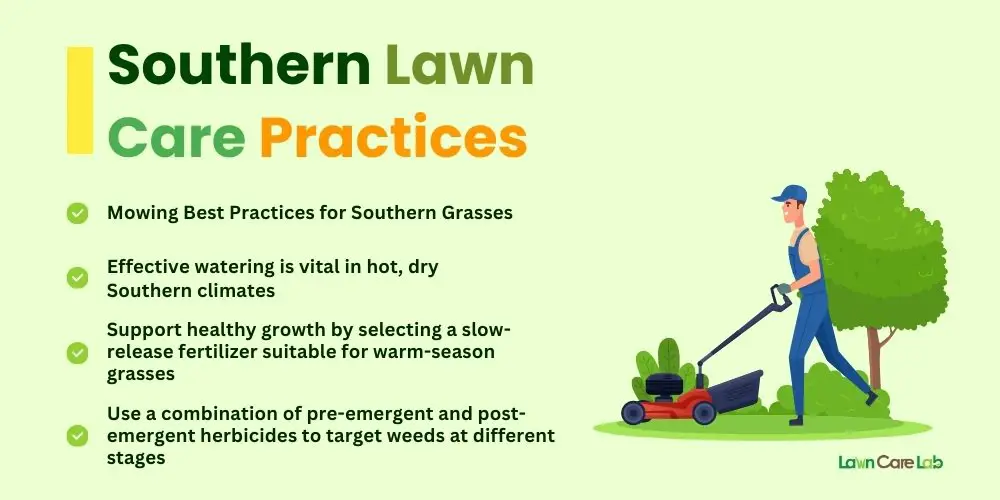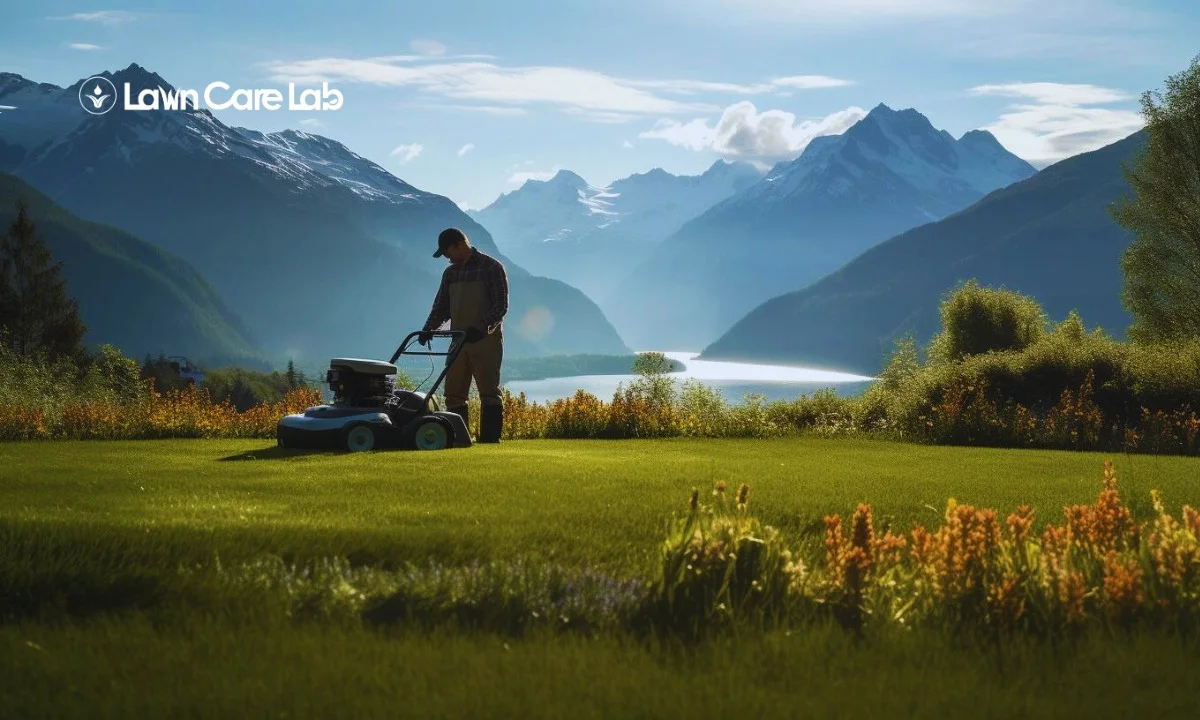Creating a successful lawn care schedule for Southern climates requires an understanding of the unique needs of warm-season grasses like Bermudagrass and St. Augustinegrass, which thrive in high temperatures.
Planning seasonal tasks—such as aerating in spring, mowing and watering during summer, overseeding and fertilizing in fall, and winterizing before colder months—will keep your lawn vibrant year-round.
Local factors, like soil type and weather patterns, also play a role; for example, sandy soils may need more frequent watering.
By planning your care routine based on these factors, you can ensure a vibrant lawn year-round.
Have you thought about the key steps that will lead to that beautiful green lawn you desire? Taking the time to understand your lawn’s needs will make all the difference.
Table of Contents
Understanding Southern Climate and Grass Types

Understanding the special features of the southern climate is key to growing a healthy lawn. In the South, you typically experience long, hot, and humid summers, which makes it a great environment for warm-season grasses such as Bermudagrass, St. Augustinegrass, and Zoysiagrass.
Knowing your exact climate, whether it’s the humid subtropical conditions of Florida or the milder weather of the Carolinas, helps you select the best grass type for your yard.
The type of soil in your area also plays a big role. For example, some places have sandy soil near the coast, while others have heavy clay inland. This affects how well your lawn holds water and how many nutrients are available.
Additionally, rainfall can vary quite a bit; some regions experience clear wet and dry seasons, while others receive steady moisture throughout the year. By understanding these elements, you can adjust your lawn care routines to create a beautiful and safe outdoor space.
Building Your Southern Lawn Care Schedule
To create a Southern lawn care schedule, plan key tasks for each season. Begin in early spring by clearing debris and applying pre-emergent herbicides to prevent weeds.
In late spring, shift to regular mowing, watering, and fertilizing to keep your lawn vibrant through summer. As fall approaches, prepare for winter by aerating the soil and applying a fall fertilizer to support root health. Finally, winterize your lawn by mowing shorter and clearing dead grass or leaves, helping it return strong in spring.
Following these seasonal steps will keep your lawn lush year-round.
Early Spring Tasks
As spring comes, caring for your lawn is crucial for its health. Start by doing core aeration. This process helps break up compacted soil, allowing air and water to reach the roots more easily.
Next, dethatching is important. It removes dead grass and debris, which helps nutrients get into the soil better.
To keep summer weeds at bay, apply a pre-emergent herbicide early in the spring. This will stop weeds from growing before they start.
If your lawn is already established, a light application of slow-release fertilizer can encourage rich green growth. It’s also a good time to check your soil’s pH level. If the pH is off, you may need to add amendments to help your grass absorb nutrients effectively.
If you have bare spots in your lawn, overseeding with the right type of grass will help fill those in.
Remember, when you water, do it deeply but less frequently. This encourages the roots to grow strong and deep.
Late Spring/Early Summer Care
As late spring and early summer arrive, it’s crucial to give your lawn extra care to help it thrive during the hot months ahead.
With warmer temperatures, you’ll want to mow your grass more often to keep it at the right height for its specific type. Aim to water your lawn more frequently, but make sure to water deeply. This helps the roots grow strong and resist drying out due to evaporation.
If you notice any weeds, using a post-emergent herbicide can be effective in controlling them. It’s also important to watch for insect pests and diseases; catching these issues early can prevent bigger problems down the line.
Lastly, consider applying a slow-release nitrogen fertilizer to support healthy growth and keep your lawn looking lush throughout the summer.
Summer Maintenance
Summer can be very hot in southern regions, making it crucial to take good care of your lawn. To keep your grass healthy during this time, it’s best to water it deeply but not too often. This helps the roots grow deep, which allows the lawn to handle dry spells better.
Also, try to mow your grass a bit higher than usual. This will help shade the ground and reduce how much water evaporates.
It’s a good idea to avoid fertilizing your lawn in the hottest months. Fertilizers can stress the grass even more when it’s already struggling with the heat.
Watch for signs that your lawn is stressed, like brown patches or wilting. If you notice these, adjust your watering schedule to give it more moisture.
Additionally, keep an eye out for pests and diseases that can harm your lawn. If you see any problems, deal with them quickly using eco-friendly solutions to ensure your yard stays healthy and vibrant all summer long.
Fall Preparations
As fall approaches, it’s important to get your Southern lawn ready for winter dormancy. Start by watering less frequently as the weather cools. Toward the end of the season, apply a winterizer fertilizer. This helps nourish the grassroots so they stay strong and ready to grow in spring.
Keep mowing your lawn until the growth slows down. Aerating and dethatching are also essential; they improve soil health and allow nutrients to reach the roots more effectively.
Consider overseeding with ryegrass or another cool-season grass to keep your lawn looking green through the winter. Regularly remove any leaves or debris to maintain a healthy environment for your grass.
Watch for pests or signs of disease and tackle any problems quickly.
Winterizing Your Southern Lawn
As winter approaches, it’s important to prepare your Southern lawn so it stays healthy and strong for spring.
Start by ensuring your lawn has good drainage. This helps prevent standing water, which can freeze and damage the roots of your grass. Try to stay off the lawn during frost or freezing weather; this protects the grass from being crushed.
Next, consider applying a light dose of potassium-rich fertilizer. This type of fertilizer helps your lawn become more resistant to cold temperatures and prepares it for the winter months.
You can also add mulch around trees and shrubs. This will keep their roots warm and help stop weeds from growing.
Taking these easy steps now will make a big difference later.
Essential Lawn Care Practices for the South

Maintaining a healthy Southern lawn requires climate-specific care. Mow at the ideal height for your grass type, water deeply and early to promote strong roots, and use a slow-release fertilizer in spring and fall.
Apply pre-emergent herbicides in early spring to prevent weeds, and choose organic pest controls to protect beneficial insects.
Mowing Best Practices for Southern Grasses
Mowing correctly enhances both appearance and grass health.
Follow these tips:
- Height: Mow at the ideal height for your grass type (e.g., Bermuda at 1–2 inches).
- Cutting Rule: Never cut more than a third of the blade at a time to reduce stress.
- Sharp Blades: Dull blades can tear grass, increasing disease risk.
- Mulching: Consider a mulching mower to return clippings, which provide natural nutrients to the soil.
Watering Techniques for a Thriving Southern Lawn
Effective watering is vital in hot, dry Southern climates:
- Timing: Water early to reduce evaporation and discourage disease.
- Depth: Deep, infrequent watering supports root resilience.
- Moisture Monitoring: Tools like rain gauges or soil moisture meters ensure balanced watering, avoiding the risks of overwatering such as root rot and fungal issues.
Fertilizing Your Southern Lawn
Support healthy growth by selecting a slow-release fertilizer suitable for warm-season grasses:
- Application Timing: Fertilize in spring and fall; avoid the hottest months to prevent stress.
- Soil Testing: Identify deficiencies with a soil test to create a precise fertilization plan.
- Phosphorus Caution: Choose fertilizers low in phosphorus to protect local waterways.
- Watering Practice: To prevent chemical burns, water before and after fertilizing and follow application guidelines for safety.
Weed and Pest Control Strategies
Control weeds and pests for a balanced, healthy lawn:
- Weeds: Use a combination of pre-emergent and post-emergent herbicides to target weeds at different stages.
- Pests: Watch for common Southern pests like chinch bugs and grubs. Early intervention is key to preventing damage.
- Eco-Friendly Options: Integrated pest management (IPM) combines natural and chemical solutions for sustainable lawn health.
By following these practices, your Southern lawn will thrive, remaining healthy and beautiful all year.
Adapting to Specific Southern Climate Conditions
To care for your lawn successfully in the Southern climate, it’s essential to understand its unique features. By adjusting your lawn care methods to fit your local environment, you can help your grass thrive.
Here are some important points to consider:
- Soil Type: Knowing whether your soil is sandy, clay, or loamy is crucial. Each type has different needs, so you may need to add materials like compost or sand to improve drainage or nutrient content.
- Watering Needs: Your watering schedule should reflect the amount of rain you receive and how quickly water evaporates in the heat. Over-watering can lead to root rot, while under-watering can stress your grass.
Using a rain gauge can help you track rainfall, ensuring you water just enough.
- Pest Monitoring: Keep an eye out for pests and diseases that are common in your area. For example, southern lawns often face issues with grubs or chinch bugs.
Using natural pest control methods, such as neem oil or insecticidal soap, can help manage these problems without harming beneficial insects.
FAQs
What Tools Are Essential for Maintaining a Southern Lawn?
How Can I Identify Lawn Pests Common in Southern Climates?
When Is the Best Time to Aerate Southern Lawns?
How Do I Handle Drought Conditions for My Lawn?
What Are the Signs of Lawn Disease in Southern Grass Types?
- How to Create a Lawn Care Schedule for Southern Climates - October 30, 2024
- How to Use Compost Tea to Boost Lawn Growth and Soil Health - October 23, 2024
- The Best Grasses for Saltwater-Exposed Lawns: Coastal Lawn Care - October 17, 2024



